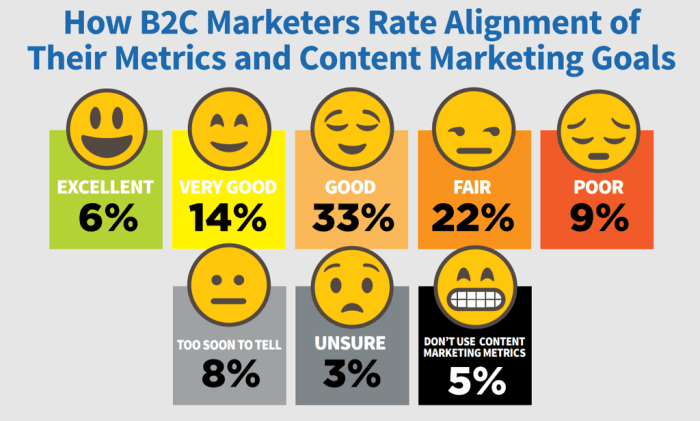Measure content marketing success sets the stage for a deep dive into evaluating your content’s impact. This guide explores defining success metrics, tracking key performance indicators, analyzing content performance, understanding attribution and ROI, optimizing content, and finally, reporting your findings. We’ll cover everything from crafting SMART goals to using analytics tools and presenting compelling data to stakeholders.
By meticulously measuring your content’s effectiveness, you’ll gain valuable insights into what resonates with your audience and how to continually refine your strategy for optimal results.
Defining Success Metrics
Defining content marketing success goes beyond just creating engaging content. It’s about measuring the impact that content has on your business goals. This involves understanding the metrics that truly reflect the value your content brings, and aligning those metrics with the overall objectives of your company. This crucial step ensures your content marketing efforts are not just entertaining, but also driving tangible results.
Quantifiable Metrics for Content Effectiveness
Understanding the effectiveness of your content marketing strategies requires a clear framework of quantifiable metrics. These metrics, when carefully chosen and tracked, provide valuable insights into what’s working and what needs improvement. A holistic approach encompassing various metrics across different content types is essential.
- Website Traffic: This fundamental metric measures the number of visitors to your website. It’s a clear indicator of how much interest your content generates and how effectively it attracts the target audience. Increasing website traffic suggests that your content is reaching the intended audience, driving them to your site.
- Engagement Metrics: These metrics capture the audience’s interaction with your content. For blog posts, this includes metrics like time spent on page, bounce rate, and comments. Social media engagement encompasses likes, shares, retweets, comments, and click-through rates. Higher engagement rates indicate that your content resonates with your audience, keeping them interested and encouraging further interaction.
- Lead Generation: The number of leads generated directly correlates to the potential for conversions. Metrics such as form submissions, email sign-ups, and contact requests are vital in tracking the effectiveness of content in generating potential customers.
- Conversion Rates: The percentage of website visitors who complete a desired action, such as making a purchase or requesting a demo, is crucial. High conversion rates signify that your content is successfully guiding users towards desired outcomes.
- Customer Acquisition Cost (CAC): This metric measures the cost of acquiring a new customer through content marketing. Tracking CAC helps assess the return on investment (ROI) of your content marketing efforts. A lower CAC indicates better efficiency in acquiring customers through your content.
Content Type-Specific Success Metrics
Different content formats require distinct metrics for evaluating success. A tailored approach is vital to accurately gauge the effectiveness of each type.
| Content Type | Metric 1 | Metric 2 | Metric 3 |
|---|---|---|---|
| Blog Post | Page Views | Time on Page | Bounce Rate |
| Social Media Updates | Reach | Engagement Rate | Click-Through Rate (CTR) |
| Videos | Views | Average Watch Time | Shares |
| Ebooks/Guides | Downloads | Time Spent Reading | Completions Rate |
Aligning Content Marketing with Business Objectives
Successful content marketing is inextricably linked to overall business goals. The content you create should directly support your company’s mission and strategic objectives. This ensures that your content marketing efforts are not isolated but rather integral to the broader business strategy. For instance, if your goal is to increase brand awareness, your content should focus on building brand recognition and positive associations.
SMART Goals in Content Marketing
SMART goals (Specific, Measurable, Achievable, Relevant, Time-bound) are crucial for effective content marketing measurement. Clearly defined goals help track progress and ensure that content marketing efforts contribute to achieving the broader business objectives. For example, instead of “increase brand awareness,” a SMART goal would be “increase brand mentions on social media by 20% within the next quarter.”
Tracking Key Performance Indicators (KPIs)
Content marketing success hinges on understanding and meticulously tracking key performance indicators (KPIs). This allows for a clear assessment of what’s working, what needs adjustment, and ultimately, the effectiveness of your strategies. By consistently monitoring KPIs, you gain valuable insights into audience engagement, website performance, and the overall impact of your content efforts.Effective content marketing isn’t just about creating engaging pieces; it’s about understanding how those pieces perform and adapting strategies based on that performance.
This requires a keen eye for tracking relevant data, which translates to measurable results.
Measuring content marketing success can be tricky, but understanding how elements like color impact user engagement is key. For example, a well-placed call to action in the right shade can significantly boost conversions. Did you know that the strategic use of color can dramatically affect your conversion rates? Learn more about how colors affect conversions and their impact on your marketing strategy here: how colors affect conversions.
Ultimately, incorporating these insights into your content strategy can lead to more measurable success in your content marketing efforts.
Common Key Performance Indicators (KPIs)
A variety of KPIs can be used to gauge the success of content marketing initiatives. These range from simple metrics like website traffic to more complex measures of audience engagement and conversion rates. Understanding these KPIs and how to track them is crucial for making data-driven decisions.
Website Traffic Tracking
Website traffic is a fundamental KPI for content marketing. It measures the number of visitors to your website. Tools like Google Analytics provide comprehensive data on traffic sources, user behavior, and the performance of individual pieces of content. Tracking website traffic helps identify popular content, understand user journeys, and pinpoint areas for improvement in content strategy.
- Tracking Methods: Google Analytics is a widely used tool that offers detailed insights into website traffic. Utilize its features to monitor page views, unique visitors, bounce rate, and average session duration. Analyze which sources are driving the most traffic (e.g., social media, search engines, referrals).
- Example: If your website traffic is low, it may indicate that your content isn’t reaching the target audience, or that the content strategy is not aligned with the target audience’s interests.
Engagement Metrics
Engagement metrics assess how actively your audience interacts with your content. Higher engagement often correlates with increased brand awareness and loyalty. These metrics include time spent on page, social shares, comments, and click-through rates.
- Tracking Methods: Tools like Google Analytics, social media analytics platforms (e.g., Facebook Insights, Twitter Analytics), and dedicated content management systems (CMS) offer ways to track engagement. Analyze the average time spent on a page, the number of shares on social media, and the number of comments on articles.
- Example: If engagement metrics are low, consider revising your content’s format or subject matter to better resonate with your target audience. A captivating headline and visual elements can also boost engagement.
Conversion Tracking
Conversion rates measure the percentage of visitors who take a desired action, such as making a purchase, signing up for a newsletter, or downloading a resource. This is a critical KPI for assessing the effectiveness of content in driving desired outcomes.
- Tracking Methods: Utilize tools like Google Analytics and marketing automation platforms to track conversions. Set up conversion goals within Google Analytics to monitor the desired actions. Implement UTM parameters to track the source of conversions.
- Example: A high conversion rate suggests your content is effectively persuading visitors to complete the desired action. Conversely, a low conversion rate may signal a need for adjustments to calls to action, content clarity, or website usability.
Analytics Tools for Content Marketing
Several powerful tools aid in content marketing data collection and analysis.
- Google Analytics: A comprehensive platform offering detailed insights into website traffic, user behavior, and conversion rates.
- SEMrush: Provides research, competitor analysis, and website audit tools to inform content strategy.
- Moz: Offers tools and insights for optimizing content for search engines.
- HubSpot: Provides marketing automation tools, including content management and analytics.
KPI Data Points and Corresponding Metrics
| Data Point | KPI | Formula/Calculation |
|---|---|---|
| Page Views | Website Traffic | Total number of page views |
| Unique Visitors | Website Traffic | Total number of unique visitors |
| Time on Page | Engagement | Average time spent on each page |
| Bounce Rate | Engagement | Percentage of visitors who leave after viewing only one page |
| Social Shares | Engagement | Number of times content is shared on social media |
| Conversion Rate | Conversions | Number of conversions / Total visitors – 100% |
Analyzing Content Performance
Knowing what resonates with your audience is key to content marketing success. Beyond simply creating great content, understanding its performance is crucial for continuous improvement. Analyzing content performance allows you to pinpoint what’s working, what’s not, and adjust your strategy accordingly. This crucial step refines your approach and ultimately drives better results.A deep dive into content performance involves more than just looking at vanity metrics.
It necessitates a comprehensive understanding of audience engagement, dissecting the success of various content formats, and recognizing patterns in the data. By adopting a systematic approach, you can identify areas for optimization, ensuring your content marketing efforts are as effective as possible.
Identifying Successful and Unsuccessful Content Pieces
Analyzing content performance requires a keen eye for identifying trends. Successful content pieces often exhibit high engagement metrics, such as increased time on page, higher click-through rates, and more social shares. Unsuccessful pieces, conversely, show low engagement, lower interaction rates, and limited sharing. These metrics, when tracked consistently, provide valuable insights into audience preferences and content effectiveness.
Identifying these trends is vital to understanding the strengths and weaknesses of your content strategy.
Understanding Audience Engagement with Different Content Formats
Different content formats attract different types of engagement. Long-form articles, for example, often encourage deeper engagement through in-depth information and detailed explanations, leading to longer sessions and higher dwell time. Short-form videos, on the other hand, excel at grabbing attention quickly and fostering viral sharing. Infographics provide a concise and visually appealing way to present data, often leading to increased social media engagement and shares.
Measuring content marketing success can be tricky, but a key part is understanding your audience. A big part of that is reaching a wider audience, and that often means translating your content into different languages. For example, if you’re trying to expand your reach, translate content different languages to connect with potential customers globally. This global reach directly impacts your content marketing success metrics, from engagement to conversions.
Each format demands a different approach to analysis and measurement.
Comparing and Contrasting Content Formats
The table below provides a comparative overview of different content formats and their typical performance metrics.
| Content Format | Typical Engagement Metrics | Strengths | Weaknesses |
|---|---|---|---|
| Long-form articles | High dwell time, high page views, detailed engagement, strong | In-depth information, establishes authority, strong potential | Can be time-consuming to create, may not be as shareable |
| Short-form videos | High viewership, quick engagement, viral potential | Captivating and engaging, quick consumption, viral potential | May not be as effective for in-depth information, can be difficult to retain audience |
| Infographics | High social shares, quick data understanding, visual appeal | Concise and visually appealing, easy to share, effective for data presentation | Limited space for detailed explanations, may not be suitable for complex topics |
Content Performance Analysis Template
A structured approach to analyzing content performance is essential. This template helps you track key metrics and identify trends.
| Date | Content Type | Engagement Metrics (e.g., views, shares, comments) | Results (e.g., increased leads, sales, brand awareness) |
|---|---|---|---|
| 2024-08-20 | Long-form article on | 1500 views, 50 shares, 20 comments | Increased website traffic by 15%, 3 new leads |
| 2024-08-21 | Short-form video tutorial | 2000 views, 100 shares | Increased social media engagement by 20%, improved brand awareness |
| 2024-08-22 | Infographic on marketing trends | 500 shares, 100 comments | Increased brand awareness, significant social media traction |
Attribution and ROI
Understanding the return on investment (ROI) of your content marketing efforts is crucial for demonstrating value and securing future budget allocations. Content attribution helps to precisely measure the impact of specific content pieces on key business outcomes, like sales and leads. This crucial step allows you to identify which pieces are driving the most significant results and optimize your strategy for maximum effectiveness.Content attribution is the process of determining which content pieces played a role in a conversion.
It goes beyond simple clicks and views, delving into the entire customer journey to understand the specific interactions that led to a sale, sign-up, or other desired outcome. This granular analysis allows businesses to see the full picture of how content impacts their bottom line, rather than relying on broad estimations. This detailed understanding is essential for calculating ROI and proving the value of content marketing.
Content Attribution and ROI Calculation
Calculating ROI requires meticulously tracking the impact of content marketing on sales and other business outcomes. Start by defining clear conversion goals (e.g., sales, lead generation, newsletter sign-ups). Implement robust tracking mechanisms, like UTM parameters in URLs, to monitor the specific channels and content pieces driving these conversions. This meticulous tracking provides crucial data for analyzing the relationship between content and conversions.
Tracking Content Impact on Business Outcomes
To track the impact of content marketing on sales, monitor website traffic, form submissions, and other relevant metrics associated with specific content pieces. This analysis will reveal the effectiveness of different types of content in generating leads and driving conversions. For instance, blog posts focused on specific pain points might be associated with a higher number of leads compared to articles focused on general topics.
By understanding the conversion rates associated with different content types, you can optimize your content strategy for better results.
Calculating ROI for Different Content Marketing Campaigns
The calculation of ROI varies depending on the campaign goals. For example, a campaign focused on lead generation might calculate ROI based on the number of qualified leads generated, while an e-commerce campaign would focus on revenue generated through content-driven sales. A simple ROI calculation formula is:
(Gain from Investment – Cost of Investment) / Cost of Investment
For example, if a campaign generated $10,000 in revenue and cost $2,000 to produce, the ROI would be (10,000 – 2,000) / 2,000 = 4 or 400%. This highlights the significant potential of content marketing to generate substantial returns on investment.
Measuring content marketing success can be tricky, but focusing on engagement metrics is key. A great way to boost those engagement numbers is by tailoring your email marketing campaigns. Implementing effective email marketing segmentation strategies, like those detailed here email marketing segmentation strategies , can significantly improve open and click-through rates. Ultimately, this targeted approach will give you a clearer picture of how your content is performing and help you refine your strategy for even better results.
Connecting Content Performance to Overall Business Revenue
Linking content performance to overall business revenue involves a thorough analysis of the entire customer journey. Identify which content pieces are most frequently viewed and engaged with by customers who ultimately convert. Use data analytics tools to determine the correlation between specific content pieces and revenue streams. By identifying the content that correlates with increased revenue, businesses can optimize their content strategy to maximize impact on overall revenue.
Methods for Attributing Conversions to Content Marketing
The effectiveness of various attribution models varies based on the complexity of the customer journey. A table outlining different methods for attributing conversions to content marketing efforts is shown below:
| Method | Description | Pros | Cons |
|---|---|---|---|
| First-Touch Attribution | Credits the first piece of content a customer interacted with leading to a conversion. | Simple to implement, easily understandable. | Ignores the impact of subsequent content interactions, potentially underestimating the overall value of content marketing. |
| Last-Touch Attribution | Credits the last piece of content a customer interacted with before a conversion. | Focuses on the immediate impact of content. | Ignores the impact of previous content interactions, potentially misrepresenting the value of earlier content. |
| Linear Attribution | Distributes credit equally among all content pieces a customer interacted with before a conversion. | Provides a balanced view of content contribution. | May not accurately reflect the varying influence of different content pieces. |
| Time-Decay Attribution | Assigns more weight to content interacted with closer to the conversion, reducing weight for earlier interactions. | Captures the influence of more recent content. | Requires more complex tracking and calculation. |
| Position-Based Attribution | Assigns credit based on the order and position of content interactions in the customer journey. | More nuanced view of content impact, considering sequence. | Can be challenging to implement and analyze accurately. |
Content Optimization Strategies: Measure Content Marketing Success

Once you’ve gathered data on your content’s performance, it’s time to put those insights to work. Content optimization isn’t a one-time fix; it’s an ongoing process of refinement and improvement. By understanding what resonates with your audience and what doesn’t, you can create more engaging and effective content. This involves analyzing various aspects, from the clarity of your writing to the overall user experience.Refining your content based on performance data is crucial for achieving your marketing goals.
Adjusting your content based on these insights allows you to adapt your approach to meet the evolving needs and preferences of your target audience. By making calculated changes, you can improve engagement, increase conversions, and boost your overall return on investment (ROI).
Improving Content Performance Based on Data
Understanding which pieces of content perform well and which underperform is essential for effective optimization. This involves identifying trends and patterns in the data to pinpoint areas needing improvement. Common metrics to examine include engagement metrics (likes, shares, comments), time on page, bounce rate, and conversion rates.
Adjusting Content Based on Performance Insights
Analyzing these metrics allows you to identify areas for improvement. For example, if a particular blog post has high bounce rates, it might indicate a lack of clarity in the introduction or a disconnect between the headline and the content. If a landing page has low conversion rates, it could be due to confusing calls to action or a poor user experience.
Successful Content Optimization Techniques
Numerous strategies can enhance content performance. These include:
- Improving clarity and conciseness: Rewriting content to be more direct, eliminating jargon, and using simpler language can significantly enhance readability and engagement. For example, if a technical article is confusing to a broad audience, rewriting it in a more accessible style can increase readership and comprehension.
- Optimizing for user experience (UX): Ensuring your content is easy to navigate, with clear headings, subheadings, bullet points, and visuals, will improve user engagement. A well-structured webpage with intuitive navigation leads to increased user satisfaction and better content performance.
- Incorporating visuals: Adding relevant images, videos, and infographics can break up text, make the content more visually appealing, and improve comprehension. For instance, a data-driven article can benefit from an infographic that visually represents the key findings.
A/B Testing Content Variations, Measure content marketing success
A/B testing is a valuable technique for comparing different versions of content to determine which performs better. For example, you could test two different headlines for a blog post to see which one generates more clicks. Or, you could test two different calls to action on a landing page to see which one leads to more conversions. This data-driven approach helps you make informed decisions about your content strategy.
A/B testing allows for iterative improvement and ensures that content choices are based on empirical evidence.
Enhancement Strategies
Improving content for search engines is crucial for increasing visibility and driving organic traffic. Key strategies include:
- research: Identifying relevant s that your target audience uses when searching for information online. Understanding your audience’s search intent is vital for creating content that directly addresses their needs.
- On-page optimization: Optimizing elements on the page itself, such as meta descriptions, title tags, and header tags, to improve search engine rankings. Using relevant s in these elements helps search engines understand the content’s topic.
- Link building: Acquiring backlinks from reputable websites in your industry to boost your website’s authority and search engine rankings. High-quality backlinks signal to search engines that your content is trustworthy and valuable.
Last Point

In conclusion, measuring content marketing success is a vital aspect of any effective content strategy. By meticulously tracking KPIs, analyzing performance, and optimizing content, you can demonstrate the value of your efforts and ensure your content marketing consistently aligns with your business objectives. This comprehensive guide equips you with the knowledge and tools to do just that. Remember, consistent measurement and adaptation are key to long-term success.








